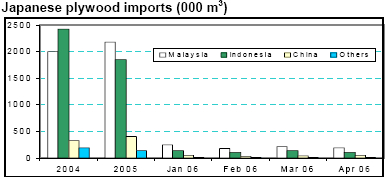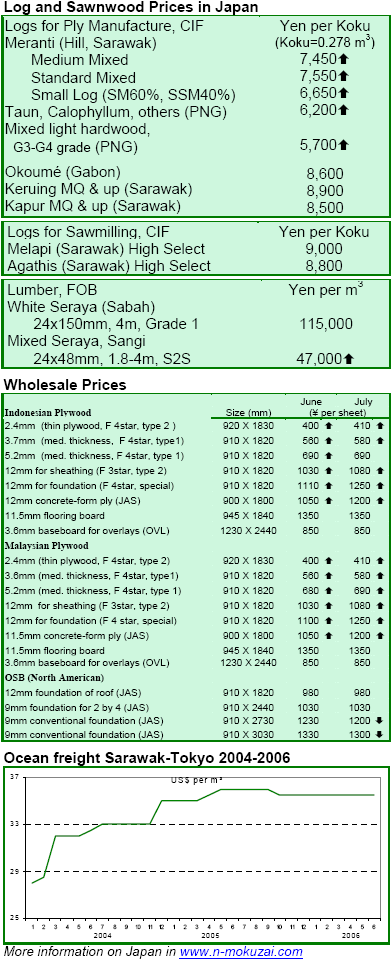Japan Wood Products Prices
Dollar
Exchange Rates of 14th July 2006
Japan Yen
116.31
Reports From Japan
Log supplies and stocks sink to new lows in Japan
Total supply of Southeast Asian logs to Japan declined substantially by 24.7% to 382,300
m3 during January-April 2006, compared with a year earlier. Log stocks in Japan are also
dipping to new lows, falling 30% to 253,200 m3 in April, equivalent to 2.4 months of
demand. In May 2006, imports of Southeast Asian lumber were 44,900 m3, bringing the total
January-May supply to
215,300 m3.
JSLC trims forecast on demand for Southeast timber
Japan¡¯s Southeast Lumber Conference (JSLC) has recently trimmed its forecast
demand of Southeast Asian logs and lumber for 2006. The new projection sets log demand at
1.34 million m3, down 6.4 % from 2005 and lumber demand at 520,000 m3, down 5%. About
90.6% of the logs would be for plywood and the balance for lumber production. The decline
is mainly due to dwindling supplies from Southeast Asia.
Chinese plywood continues to gain market share
Japanese imports of plywood (regular, special, blockboards, etc.) in April declined 14% to
367,000 m3 (down 6.7% to ?7.49 billion CIF), compared with April 2005. Imports from
Malaysia fell 4.5% to 192,000 m3 while those from Indonesia dropped 36% to 112,000 m3. In
contrast, imports from China showed their tenth consecutive monthly increment in April,
reaching
54,000 m3, up 56% from the same month last year.

Overall, Japanese imports from Indonesia have declined 29% to
500,000 m3 in the first quarter of 2006, compared with the same period last year. In
contrast, supplies from Malaysia grew 9.6% to 836,000 m3 in the first quarter of 2006,
accounting for 54% of total plywood imports. Imports from China reached 171,000 m3 in the
first quarter of 2006, up 44% from the same period in 2005.
Indonesia¡¯s plywood exports to halve in 2006
Japan Lumber Importers Association (JLIA), Japan Federation of Plywood Manufacturers,
Indonesian Plywood Association (Apkindo), Malaysian Panel Manufacturer¡¯s
Association (MPMA) and Sarawak Timber Association (STA) recently held a plywood conference
in Singapore. Apkindo and STA informed their Japanese counterparts that higher prices are
not
expected to result in increased exports because of the worsening log supply problem.
Apkindo further informed that Indonesia¡¯s plywood export volume continued to
decline in the first half of 2006 and was expected to halve to 1.5 million m3 by the end
of the year, down from 3.4 million m3 in 2005. Apkindo said it was aware that the current
situation could speed up substitution in Japan, but it believed it was still a dominant
supplier of quality thin plywood. Regarding
concrete forming plywood, both Indonesia and Malaysia agreed that this product had not
been very profitable in the last decade.
Housing starts hit fourth consecutive monthly rise
Housing starts reached 108,652 units in May, up 6.7% from May last year and the fourth
consecutive monthly gain. Total housing starts during January-May 2006 has risen 7.3% to
504,124 units over the corresponding period in 2005. Seasonally adjusted annual housing
starts
stood at 1,294,000 units. Wood based units rose to 47,883, up 4.3% from May last year, due
to an increase in owner-occupied units (up 4.5%). Wooden units accounted for 44.1% of the
total housing starts in May, up 2.6 points from the previous month. The general recovery
of the economy and improved corporate performance continued to encourage construction
activity
in the country.
JLIA to verify other panel products
The Japan Lumber Importers Association (JLIA) has announced that it will verify the
legality and origin of imported fiberboard, particleboard and OSB products in addition to
primary products such as logs, lumber and plywood. JLIA indicated that, since this year,
any JLIA member importing these products would need to pay a fee to the association.
Prices of panel adhesives raised by 10-16%
Oshika Corporation, a major Japanese adhesive manufacturer, raised by 10-16% the prices of
adhesive of melamine, phenol and urea for the manufacturing of fiberboard and plywood as
of 1 July. The price rise was due to higher fuel costs, particularly naphtha. The last
price hike took place in April 2005. Oshika had also raised prices of adhesives for the
woodworking, furniture
and laminated lumber by 10-15%.
Japan ends ¡ˇăzero-rate¡ˇŔ policy
The Bank of Japan has decided to end its zero interest rate policy and lift the overnight
call rate target to 0.25%, putting an end to more than six years of zero interest rates.
The central bank indicated it expected to keep interest rates very low for some time and
would take a gradual approach to any further tightening.

ˇˇ |